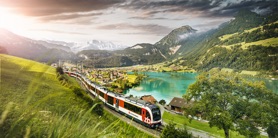Menu
Zoeken
Engineering fact sheet
The new high-speed link through the Alps calls for a high degree of precision in the construction. Reliable and highly accurate surveying techniques enable the route to be defined down to the millimetre.
Tunnel surveying
To survey the tunnel, satellite measurement technology was used across the entire project area to create a network of fixed points. Due to the huge dimensions of the long, underground tunnels, organisation of the tunnel survey constituted a major logistical challenge. The final breakthrough of the Gotthard Base Tunnel took place on 15 October 2010, approximately 30 km from the south portal and 27 km from the north portal. The breakthrough was extremely accurate with a horizontal deviation of just 8 cm and a vertical deviation of 1 cm, making it one of the most precise breakthroughs in the history of tunnel construction.
Excavation methods
Four tunnel boring machines excavated almost 75% of the Gotthard Basel Tunnel, with blasting used for the remaining 25%. The choice of tunnelling method depended not only on the expected rock conditions, but also on development opportunities, environmental conditions and economic realities. The length of the route and the planned overall construction period also played a role.
Tunnel boring machine
A tunnel boring machine with a drilling head diameter of up to 9.5 m and driving equipment is approximately 450 m in length. A single tunnel boring machine costs about CHF 30 million. These machines are particularly suitable for longer routes, as the procurement and provision of installation takes longer than for conventional tunnelling with drilling, blasting and clearing.
Interior construction
After excavating the rock, the tunnel bore was reinforced to prevent rock falls and protect workers. Reinforcing elements of varying degrees of strength were used depending on the geological conditions. Anchors, shotcrete and steel arches can be combined modularly. This is followed by application of a sealing foil, which protects the tunnel bores from water ingress. For the Gotthard Base Tunnel, appropriate systems were developed to meet the specific requirements and conditions. The interior lining of the tunnel, which serves as the supporting structure, must last for 100 years without significant maintenance work. Therefore, the high quality and service life of the construction materials were of paramount importance.
Shell work equipment
Mechanical and electromechanical equipment was installed in the Base Tunnel before installation of the rail infrastructure. Two examples: An operational ventilation system ensures an optimum working environment for maintenance work, and supplies fresh air and smoke extraction in the event of fire. A drainage system takes mountain water and contaminated water caused by accidents out of the tunnel through separate pipes.
Source and more information available at: https://www.alptransit.ch/de/medien/publikationen/
Download factsheet
